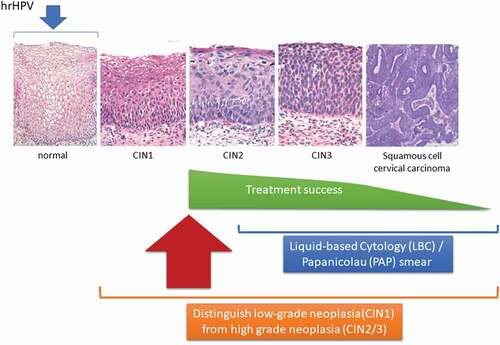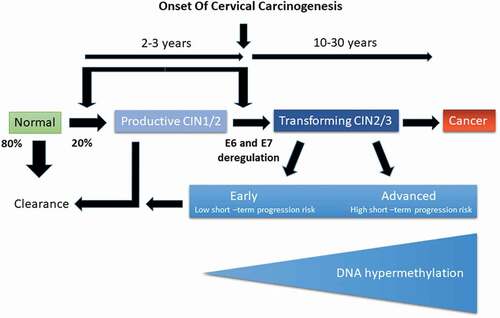Figures & data
Figure 1. Flow chart of Dutch population-based screening for cervical cancer (numbers are from 2019). ASCUS (Atypical Squamous Cells of Undetermined Significance) [Citation4]
![Figure 1. Flow chart of Dutch population-based screening for cervical cancer (numbers are from 2019). ASCUS (Atypical Squamous Cells of Undetermined Significance) [Citation4]](/cms/asset/ac6bb0a5-aa30-45e8-87b1-a69f2e9feb71/ieru_a_1980387_f0001_oc.jpg)
Figure 2. Progression from normal cervical tissue to CIN3 and further to invasive cervical cancer after an hrHPV infection. Women with a diagnosis of CIN1 are usually left untreated and invited for the next screening interval. The treatment of most women with a diagnosis of CIN2 is successful in preventing progression to the more severe stages, which has greatly diminished the incidence of cervical cancer and the associated mortality, mostly in high-income countries. Treatment success diminishes considerably upon further progression to cervical carcinoma. LBC: a method for preparing cervical samples in cytopathology; PAP: a screening test for the presence of HPV

Figure 3. Schematic representation of epigenetic processes following infection with hrHPV. While 80% of infections are cleared by the immune system, 20% persist leading to CIN1/2 lesions. Most of these persistent infections will be resolved by the immune system with clearance of the infection. Deregulation of E6 and E7 expression is a critical event that changes a productive CIN1/2 lesion (one that produces viral particles without progressing) into a transforming CIN2+ lesion. Transforming CIN2+ lesions may carry an elevated risk of progressing to cancer during the ensuing screening interval (high short-term risk) or not (low short-term risk). The risk of progression is correlated with changes in the methylation status of both host and viral DNA. Hallmarks of a high-risk lesion are a persistent infection of more than five years, elevated copy number alterations, low expression of E4, and DNA hypermethylation, while low-risk lesions show the opposite characteristics (adapted from Kremer et al., Bjog 2021, 128(3):504–514)

Table 1. Selected DNA methylation studies with high-grade CIN and cervical cancer as endpoints.Footnote1 All studies used QMSP as detection method
Table 2. Selected studies based on proteins related to cell division and DNA replication. All studies used IHC as detection method. The p16/Ki-67 studies were performed with the CINTec® PLUS assay (Roche)
Table 3. Selected cost-effectiveness analyses that calculate the cost per QALY gained of primary HPV screening strategies in different countries
